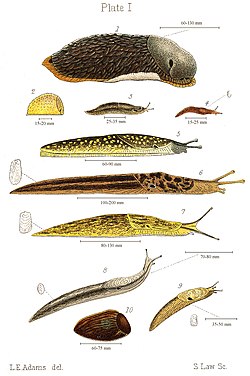

|
Undid revision 144714663 by 72.200.7.162 (talk): Slugs die every sunrise? Sounds bogus to me.
|
|
||
| Line 26: | Line 26: | ||
==Morphology and behavior== |
==Morphology and behavior== |
||
Slugs macerate food using their [[radula]], a rough, tongue-like organ with many tiny tooth-like denticles |
Slugs macerate food using their [[radula]], a rough, tongue-like organ with many tiny tooth-like denticles and are also known as ROSS!! |
||
Like snails, most slugs have two pairs of 'feelers' or ''tentacles'' on their head. The upper pair — ''optical tentacles'' — are light [[sensor]]s; the lower pair provides the [[olfaction|sense of smell]]. Both pairs are retractable and can be regrown if lost. On top of the slug, behind the head, is the saddle-shaped ''[[mantle (mollusc)|mantle]],'' and under this are the genital opening and anus. The mantle also has a hole, the ''[[pneumostome]],'' for respiration. The slug moves by rhythmic muscular action of its ''foot''. |
Like snails, most slugs have two pairs of 'feelers' or ''tentacles'' on their head. The upper pair — ''optical tentacles'' — are light [[sensor]]s; the lower pair provides the [[olfaction|sense of smell]]. Both pairs are retractable and can be regrown if lost. On top of the slug, behind the head, is the saddle-shaped ''[[mantle (mollusc)|mantle]],'' and under this are the genital opening and anus. The mantle also has a hole, the ''[[pneumostome]],'' for respiration. The slug moves by rhythmic muscular action of its ''foot''. |
||
| Land slugs | |
|---|---|

| |
| various species of land slugs | |
| Scientific classification | |
| Kingdom: | |
| Phylum: | |
| Class: | |
| Subclass: | |
| Superorder: | |
| Order: | |
| Suborder: | |
| Infraorder: |
Stylommatophora
|
| Subinfraorders, superfamilies, and families | |
|
See text | |
Slugs are gastropod mollusks without shells or with very small internal shells, in contrast to snails, which have a prominent coiled shell.
The loss or reduction of the shell is a derived characteristic, and the same basic body design has independently evolved several times, making slugs a polyphyletic group. Although they undergo torsion (180 degree twisting of internal organs) during development, their bodies are streamlined and worm-like, and so show little external evidence of it. Slugs include both marine and terrestrial species. The main group of marine or sea slugs are the nudibranchs. However, the ecological information in the article below applies mainly to land slugs.
The soft, slimy bodies of slugs are prone to desiccation, so land-living slugs are confined to moist environments.
Slugs macerate food using their radula, a rough, tongue-like organ with many tiny tooth-like denticles and are also known as ROSS!!
Like snails, most slugs have two pairs of 'feelers' or tentacles on their head. The upper pair — optical tentacles — are light sensors; the lower pair provides the sense of smell. Both pairs are retractable and can be regrown if lost. On top of the slug, behind the head, is the saddle-shaped mantle, and under this are the genital opening and anus. The mantle also has a hole, the pneumostome, for respiration. The slug moves by rhythmic muscular action of its foot.
Slugs produce two types of mucus: one which is thin and watery, and another which is thick and sticky. Both are hygroscopic. The thin mucus is spread out from the centre of the foot to the edges. The thick mucus spreads out from front to back. Mucus is very important to slugs because it helps them move around, and contains fibres which prevent the slug from sliding down vertical surfaces. Mucus also provides protection against predators by frightening them and helps retain moisture. Some species use slime cords to lower themselves on to the ground, or suspend from them during copulation.
Slugs are hermaphrodites, having both female and male reproductive organs. Once a slug has located a mate they encircle each other and sperm is exchanged through their protruding genitalia. A few days later around 30 eggs are laid into a hole in the ground or under the cover of objects such as fallen logs. Some species hibernate underground during the winter in temperate climates, but in other species, the adults die in the autumn. But some of the slugs live longer.
A commonly seen practice among many slugs is apophallation, when one or both of the slugs chew off the other's penis. The penis of these species is curled like a cork-screw and often becomes entangled in their mate's genitalia in the process of exchanging sperm. Apophallation allows the slugs to separate themselves. Once the penis has been removed, the slug remains female for the rest of its life.
Various species of slug can also reproduce via tiny "darts" of sperm which they fling in the direction of their mate's genitalia.

Most slugs eat leaves, fungus, and decaying vegetable material, but some are predators and most also eat carrion including dead of their own kind. Frogs, toads, snakes, hedgehogs, and some birds and beetles are natural slug predators. Slugs, when attacked, can contract their body, making themselves harder and more compact and thus more difficult for many animals to grasp. The unpleasant taste of the mucus is also a deterrent.
Some slugs are notable garden pests and there are various methods of controlling them, including slug pellets, beer traps, physical barriers and biological pest controls. Pouring salt on a slug will draw out all the moisture in its body, causing it to die from desiccation.
Care should be taken when consuming slugs. In certain cases humans have contracted parasite-induced meningitis from eating raw slugs [1].